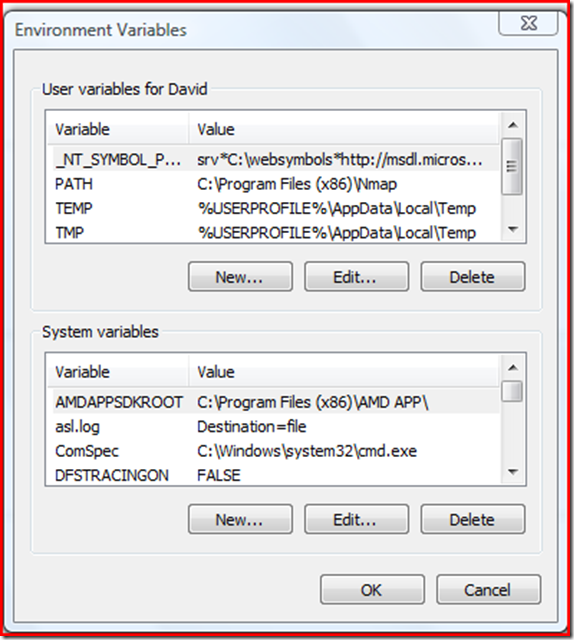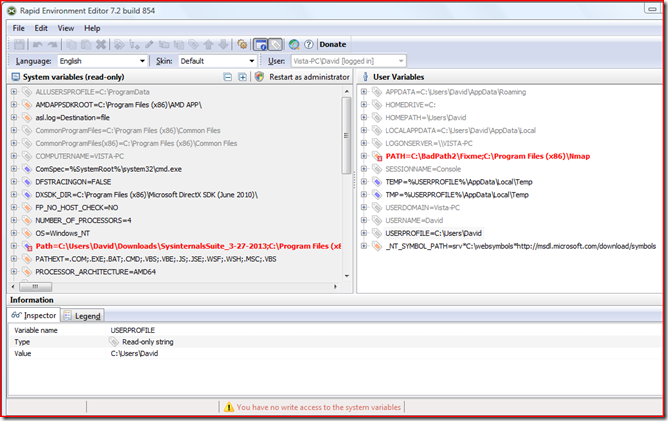Over the years I have found several tools that make a good or great addition to my PC Repair toolbox. Some you use every day and others you only pull them out on occasion.
I hope to write up several that I have used.
This first one came when I was looking recently for a better way to check and modify the Environment Variables for the system.
The normal way is to go to Control Panel –> System –> Advanced System Settings –> Environment Variables . Then you could scroll and find the variable name you want in the list, and then select the name, and then click edit, then scroll the long string or copy paste to notepad then make the modifications, then copy paste back and save. As you can see below it is not easy to see what you have there especially if there are allot in one line.
Now that is not very handy for viewing the big picture. You can not even make the window bigger. Even if you click the edit button for a variable name it is hard to work with and you may still need to copy to notepad, edit it then copy back.
The most promising program I found on a internet search was one called “RapidEE” located here http://www.rapidee.com/en/download .
What I like the most is it comes as an Installer or as a Zip file so you can drop it on a flash drive and use it portably without having to install it if you have several systems to look at.
This tool also has a built in crash report system. So if it crashes for some reason you can save the report locally or allow it to be sent to the creator if the need would arise.
When I first tested this program (Version 7.1 Build 841) it had a bug in it that crashed the application in a seemingly random way. After several emails back and forth with the Creator I was able to send the instructions to make the bug reproducible and gave my comments on what was displayed in the bug report and within a day they were able to find and correct the bug now that they could consistently reproduce the bug.
So if you tried that version (7.1 Build 841) and blew it off, try the latest version, as it works well.
So far I haven’t been able to break it again : )
The program starts up as standard user in Vista (the OS this was tested in) and you are able to edit the user variables but not the the system variables until you restart the program as an Administrator or right click and run as admin from the beginning.
It has a button to restart as admin. too.
As you can see by the screenshot above there are some variable names in red, that indicates that there is a bad path in the variable name. If a program removes its environment variable path from the list it can still show up as red because a “Null” or Empty path will show as an error. You see that when you have an entry like “path,,path”. The two commas side by side like that indicate that a environment variable path was removed from between the two paths.
You may also notice the warning icon at the bottom. That indicates that you are running the program as a standard user and would need to elevate in order to edit the system variables.
Before making any changes or if you are just curious where the settings are stored you may want to (run as admin) go to the file menu and select backup. This will back up all of the setting as a registry key backup for both the user and system environment variables.
By backing them up before hand you can restore them if you make a mistake or something goes wrong while editing them. Like me. I hate when the mouse jumps and you delete the wrong thing with out first backing it up. (That’s my story and I’m sticking to it.)
This tool will change them instantly after you press the save but they will not be reflected till the next boot if the variable path is currently in use, that I have found so far.
Lets talk about a few of the other features.
You may be able to see above that the variable names are displayed as a tree view. You can expand the individual variable name and edit or view the the individual paths. You can also narrow in on the item that caused the variable name to be flagged red.
As you install and uninstall programs sometimes the variable paths are left after uninstalling them leaving several bad paths. I should have taken a screen shot before I did the edit so you can see what variable path were left behind on my system from programs that were tested, there were several.
The two windows are for the user and the system variables that you can edit. The user variables can be edited with out being elevated. There are several right click menu items for both sides.
When you first start out in standard user mode you will notice that there are some variable names that are greyed out and you can’t edit them, For the most part you would never need to edit those as the system takes care of those and might cause a few problems if you just deleted them. (good feature for those that don’t know what the variables do)
The right click options allow you to add new variable names, add new paths, reorder the path variables in the list, and more.
This can be a great tool for quickly going in and get a quick overview on what is there.
Checking for bad or missing paths, or for quickly adding a new path to a variable name.
If you haven’t already checked this one out then give it a spin.
This program is “Free Ware” / “Donation Ware” so if you like it, then you how that works. (there is a button for that too)
I hope others find this tool as useful as I did.
That’s it for this time.


